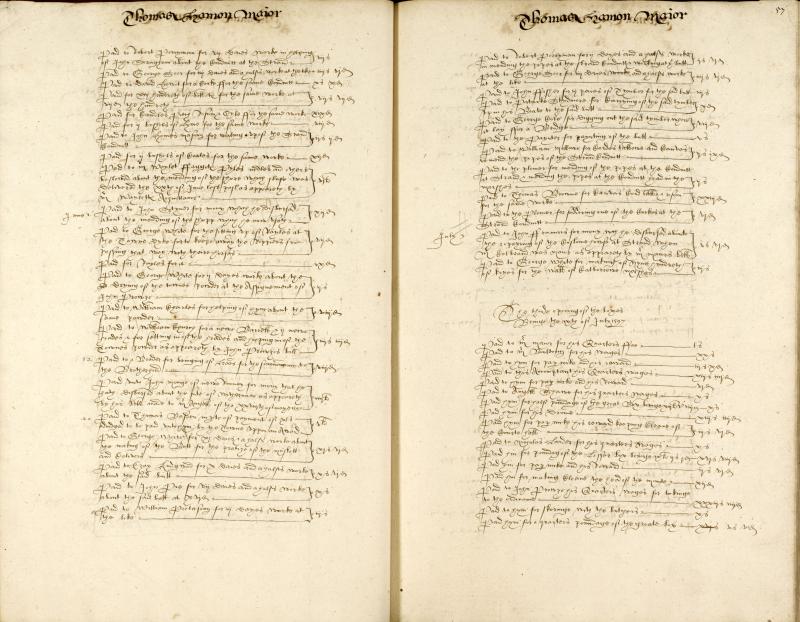Terms of use
This document is held in a Collection deposited at East Sussex Record Office, ref RYE 60/10. East Sussex Record Office, acting on behalf of the owner of the Collection, has contributed the image to Shakespeare Documented, and the owner of the Collection retains sole ownership of said image. Visitors may download, link to and cite the images within Shakespeare Documented in personal research only. Any further use, including, but not limited to, unauthorized downloading or distribution of the images is strictly prohibited. Visitors must contact East Sussex Record Office to request additional use, at thekeep@eastsussex.gov.uk or East Sussex Record Office, The Keep, Woollards Way, Brighton BN1 9BP, United Kingdom.
Document-specific information
Title: Chamberlain's accounts, 1593-1606
Date: 1593-1606
Repository: East Sussex Record Office, Brighton, UK
Call number and opening: RYE 60/10, fols.
Rosie Brocklehurst Franczak, "Rye Chamberlain's Accounts: Payment to the Lord Chamberlain's Players for 20 shillings," Shakespeare Documented, https://doi.org/10.37078/991.
East Sussex Record Office, RYE 60/10. See Shakespeare Documented, https://doi.org/10.37078/991.
This document, part of the Rye Chamberlain’s Accounts, includes an August 1597 entry for a payment of 20 shillings to Shakespeare’s company, the Lord Chamberlain’s Men. At the time, the company was on a provincial tour visiting the Cinque Port of Rye, in Sussex, as well as Dover, Bristol, Bath, Marlborough, and possibly Faversham. They went on tour after a July 28 Privy Council order led to the closure of the London playhouses until Allhallowtide (October 31 to November 2). It is not known whether Shakespeare joined the tour or what plays were performed at Rye. The meager payments by municipal authorities suggests that companies may have supplemented their expenses by performing in private houses en route (for example, the King’s Men were paid 30 pounds for a performance at Wilton in 1603).
The first entry on folio 59 recto of the Rye Chamberlain’s accounts for August 1597 reads:
Paid for a reward given to my Lord Chamberlen’s
Players at the Assignement of Mr Maior XXs
Folio 58 recto notes that the 20 shilling payment was made on August 27:
The laste opening of the Boxes
Being the xxvijth of August.
The “Great Box” and the “Lesser Box” housed the Rye tax revenues. Accounts were entered retrospectively under the name of the Mayor who had ordered the expenditure. Rye mayor-making took place in public on the first Sunday after St. Bartholomew’s Day, which in 1597 fell on August 24. Therefore, Thomas Hamon, whose yearlong mayoralty ended the following day, Sunday, August 28, ordered the payment to the players on August 27. This suggests that Mayor Hamon paid the Lord Chamberlain’s men for their involvement in celebrating the imminent election of the new mayor, John Fowtrell (whose name is shown on folio 61). Previous scholarship has suggested that the payment was made in early September, but the date of the opening of the boxes suggests that it was contemporaneous with the mayor-making.
Provincial tours by the London companies were not unusual. Outbreaks of plague had seen London playhouses closed by the authorities in previous summers. The 1597 tour was different as it was set against a background of food shortages and an increase in vagrancy, following three consecutive years of failed harvests, and the authorities may have been particularly alert to the dangers of riotous assembly. The Privy Council may well have been prompted to close the playhouses after a performance at The Swan on Bankside of a “seditious” play, “The Isle of Dogs,” now lost, written by Thomas Nashe and Ben Jonson. Although often linked to The Isle of Dogs, the prohibition does not mention any specific play, and it was not until August 15, some two weeks later, that Privy Council ordered the interrogation of those responsible for the performance (For detailed insight into The Isle of Dogs, see Ingram, pgs. 168-190).
Written by Rosie Brocklehurst Franczak
Sources:
Louis Cameron, ed. Sussex, Records of Early English Drama (Toronto: University of Toronto Press, 1989): 142.
E.K. Chambers, William Shakespeare. A Study of Facts and Problems (Oxford: Clarendon Press, 1930): 2:321.
Peter Davison, "Commerce and Patronage: the Lord Chamberlain’s Men’s Tour of 1597," in Shakespeare Performed: Essays in Honor of R.A. Foakes, ed. Grace Ioppolo (London: Associated University Presses, 2000).
Peter Davison, "Of Sugar-loaves and Horsemeat : the Value of Archives and the Limitations of Their Printed Forms," in Essays in Memory of Robin Rider, ed. William Marx (Lampeter: Trivium, 1997).
Giles Dawson, ed. "Records of Plays and Players in Kent, 1450-1634" Malone Society Collections, vii (1965).
James M. Gibson, ed. Kent: Diocese of Canterbury Sussex, Records of Early English Drama 3 vols. (University of Toronto Press and The British Library, 2002).
Michelle L. Matthews Franczak (now Myszka Fox), "The Chamberlain’s Men in Rye: St Bartholomew’s Day, 1597". Master’s thesis. (Centre for Medieval and Tudor Studies, University of Kent at Canterbury. October 2000).
William Ingram, A London Life in the Brazen Age: Francis Langley, 1548-1602 (Cambridge, Massachusetts: Harvard University Press, 1978): 168-190.
Lost Plays Database. "The Isle of Dogs." Ed. Roslyn L. Knutson, David McInnis, and Matthew Steggle. Melbourne: University of Melbourne, 2009. <https://lostplays.folger.edu/Isle_of_Dogs,_The>
Rye Chamberlain’s Accounts RYE/60/10: The Sussex Archive, The Keep, Falmer, East Sussex.
John Tucker Murray, English dramatic companies, 1558-1642 (London: Constable and Company Limited, 1910): 11:387.
B.M. Ward, "The Chamberlain's Men in 1597," The Review of English Studies vol. 9, no. 34 (1933).
Last updated August 7, 2023












